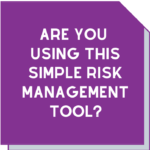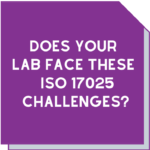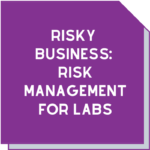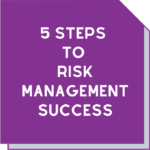Risk appetite – how hungry are you?
written by Maree Stuart
 When we think of risk and risk management, we often first ponder how we get rid of it.
When we think of risk and risk management, we often first ponder how we get rid of it.
Indeed, in the COVID-19 Pandemic, many Australians, and governments, have shown themselves to be a very risk-averse lot! In contrast, some have shown themselves to be really tolerant of health risks in comparison with perceived economic risk. And those views can change at any point in time, depending on the circumstances faced by the decision maker.
We’ve written previously on the 5 steps to risk management success and ways to deal with risk. In this article, we dig deeper into the concept of risk appetite.
What is a Risk Appetite?
PricewaterhouseCoopers (PwC) attempts to explain risk appetite in plain English. PwC defines risk appetite as ‘the amount of risk an organisation is willing to accept in pursuit of strategic objectives’.
The Committee of Sponsoring Organizations of the Treadway Commission (COSO), an organisation with support from several professional accounting associations, defines risk appetite as ‘the types and amount of risk, on a broad level, an organisation is willing to accept in pursuit of value.’
It encapsulates the attitude of the organisation towards risk taking and how it faces uncertainty. But this attitude can change depending on the type of risk faced by the organisation. For instance, in a lab setting, we might be averse to risks relating to the use of chemicals. And we would be VERY intolerant of poor behaviour and handling of chemicals. But when it comes to method development, the same lab might be more willing to ‘give it a go’ and take on new risks in terms of technology in the pursuit of an objective or strategy for success.
Each organisation will have a unique risk appetite to deal with the strategy and particular attributes of the organisation.
Why is risk appetite important?
Articulating the organisation’s risk appetite helps with good decision making. It gives decision-makers throughout the organisation a signal of how much risk they can take on board, and create, in doing what they do at the strategic, tactical, and operational, everyday levels of business.
“Not everything that can be counted counts, and not everything that counts can be counted”
– Albert Einstein
How do we set a risk appetite?
The first thing to realise is that there may be several appetites, depending on the type of risk.
 Like so much else in Quality, the best approach is not to jump in and write down the first thing that pops into your head. Instead, forming a group to brainstorm or talk through what this looks like is a great start.
Like so much else in Quality, the best approach is not to jump in and write down the first thing that pops into your head. Instead, forming a group to brainstorm or talk through what this looks like is a great start.
Who should be in that group?
Well, many people think it’s the job of the Board of Directors to do this job. But they may not be the best people to initiate the process of setting the risk appetite because they aren’t necessarily the people who deal with the everyday uncertainties a business can face.
Really, this is something that management should be involved in. The caveat is that they understand the strategy, goals, risk taking experience, risk culture and stakeholder’s perspectives of the organisation.
Next comes the analysis
Some things to consider in this step are:
- The organisation’s mission and vision – that’s the big picture of what you want to be and achieve
- The strategic direction of the organisation – what are the priorities?
- The minimum level of risk needed to drive performance
- Stakeholder views
- The existing risk profile for the organisation
- Organisational culture.
From this analysis, management should be able to establish a set of risk appetites to address different types of risk. These need to be clearly articulated. If your lab is governed by a Board of Directors, then the risk appetite(s) should be communicated to them. This ensures that the people ultimately legally responsible for any liabilities of the company are comfortable with the level of risk that the organisation will take on.
An example risk appetite statement is as follows:
Mylab, a laboratory to help clients understand the components of their materials, will pursue new programs that enhance the delivery of services to those in need within our financial ability. We will accept moderate risk to the safety of staff as we perform our testing. In order to maintain good stewardship of our investors and shareholders funds, we have a low appetite for risks related to purchasing, impartiality and misuse of funds.
It’s also a good idea to validate these risk appetite settings against previous decisions. Not only does this show how a risk appetite has changed over time to fit the context, but also highlights any unknown biases of decision-makers, particularly if there were cultural factors that affected these decisions.
Making the risk appetite known
There’s no point in going through this hard work if the people responsible for dealing with risk every day aren’t given the details to guide them in their decision making.
Communicating the risk appetite is something that should be done like voting – early and often. 😉 As well as communicating this in a policy or procedure, consider other ways to get the message across. This can include staff meetings, training, and embedding it into tolerances and acceptance criteria. Communicate details of not only the ‘what’ but also the ‘how’ to apply the risk appetite.
And like so much in Quality, after you’ve communicated your risk appetites, periodically review these to make sure that they still fit the bill.
 Want to know more about Risk Management and how risk appetite fits in? Our training course on Risk Management in the Laboratory (Risky Business) is just what you need!
Want to know more about Risk Management and how risk appetite fits in? Our training course on Risk Management in the Laboratory (Risky Business) is just what you need!
We’ll guide you to create and implement a risk management strategy that supports your lab’s goals and ensures risk minimisation.
You’ll become competent in confidently identifying, evaluating, and managing risk. You’ll learn how to apply a risk management process and strategy that aligns with your lab’s strategy.
This will ensure that you increase productivity and manage your laboratory better and smarter while continuing to comply with accreditation and certification criteria.
If you’d like to discuss your lab’s risk appetite or risk management approach, phone Maree (0411 540 709) or email info@masmanagementsystems.com.au
Remember, you don’t have to do this alone!
Download the article Risk appetite – how hungry are you?





